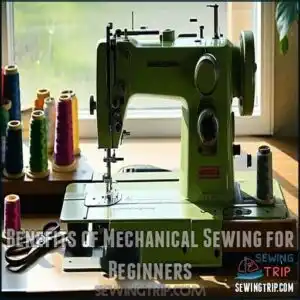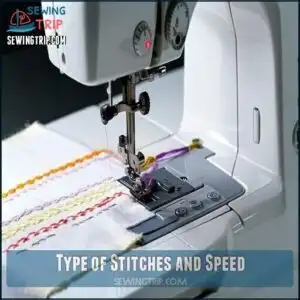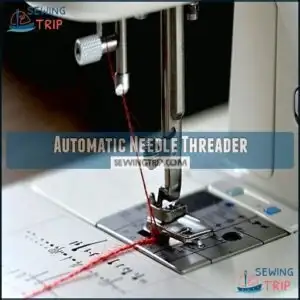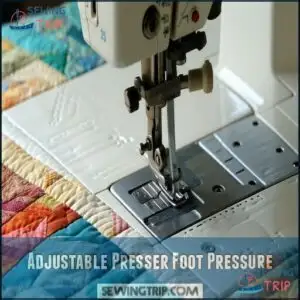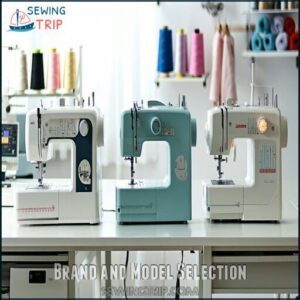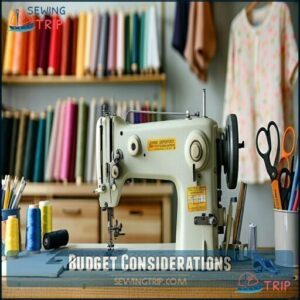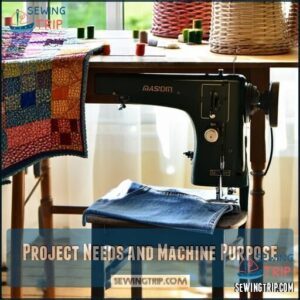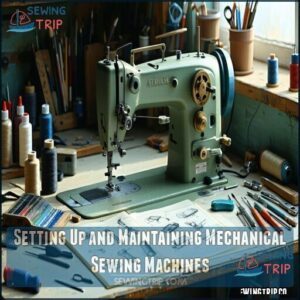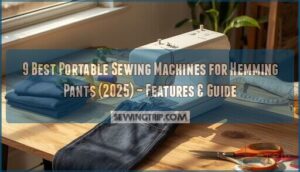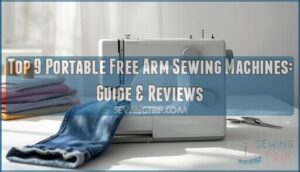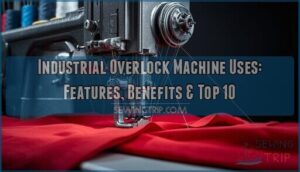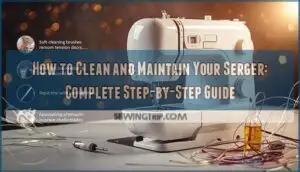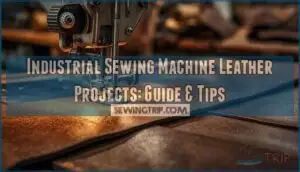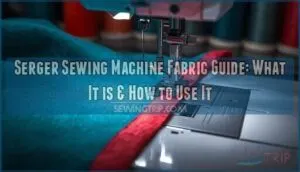This site is supported by our readers. We may earn a commission, at no cost to you, if you purchase through links.
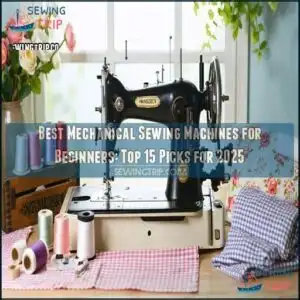
Models like the Brother XM2701, Singer M3330, and Janome Blue Couture shine with their simple controls, sturdy builds, and beginner-friendly options like automatic needle threaders and stitch adjustments.
Mechanical machines are low-maintenance, budget-friendly, and teach the essentials without overwhelming you with tech.
Think of them as your training wheels for sewing—uncomplicated, but plenty efficient.
Whether you’re mending clothes or starting a project, these machines make sewing enjoyable.
Ready to dive deeper? There’s a lot more to explore just ahead!
Table Of Contents
- Key Takeaways
- Benefits of Mechanical Sewing for Beginners
- Key Features for Beginner Sewing Machines
- Top 15 Mechanical Sewing Machines for Beginners
- 1. Brother XM2701 Sewing Machine
- 2. Bernette 35 Swiss Design Sewing Machine
- 3. Bernette 33 Swiss Design Sewing Machine
- 4. Singer M1000 Sewing Machine
- 5. Singer 7285Q Quilting Sewing Machine
- 6. Janome Blue Couture Beginner Sewing Machine
- 7. Singer M3330 Beginner Sewing Machine with Accessory Kit
- 8. Singer MX60 Portable Sewing Machine with Accessories
- 9. Janome HD3000 Heavy Duty Sewing Machine
- 10. Brother GX37 Sewing Machine 37 Stitches 6 Feet
- 11. Singer SM024 Beginner Sewing Machine with Accessory Kit
- 12. EverSewn Sparrow 15 Mechanical Sewing Machine
- 13. Brother ST371HD Strong Tough Sewing Machine
- 14. Singer Heavy Duty 4423 Sewing Machine with Accessory Kit
- 15. Janome 2212 Sewing Machine 12 Stitches
- Choosing The Right Mechanical Sewing Machine
- Setting Up and Maintaining Mechanical Sewing Machines
- Frequently Asked Questions (FAQs)
- Conclusion
Key Takeaways
- You’ll want to pick a mechanical sewing machine for its simplicity, durability, and beginner-friendly features like easy threading and straightforward stitch adjustments.
- Brands like Brother, Singer, and Janome offer reliable options for beginners, balancing affordability and quality without unnecessary complexity.
- Mechanical models require less maintenance but still handle essential tasks, making them ideal for building confidence and mastering the basics.
- Features like automatic needle threaders, adjustable presser feet, and basic stitch varieties are game-changers for beginners learning the ropes.
Benefits of Mechanical Sewing for Beginners
Mechanical sewing machines are perfect for beginners because they’re simple to use, reliable, and focused on essentials.
Simple, reliable, and focused on essentials—mechanical sewing machines make learning the art of sewing enjoyable and frustration-free for beginners.
You’ll spend less time troubleshooting and more time confidently learning the basics, stitch by stitch, with reliable machines.
Ease of Use for Beginners
Starting with a beginner sewing machine shouldn’t feel like rocket science.
Mechanical sewing machines are user-friendly, offering intuitive controls and simple threading for hassle-free operation. They shine in beginner projects, thanks to clear instructions and minimal setup.
Here’s why they’re great for learners:
- Straightforward dials simplify stitch adjustments.
- Manual threading teaches foundational skills.
- Compact designs suit smaller workspaces.
Low Maintenance Requirements
A mechanical sewing machine is a low-maintenance, reliable sewing machine, perfect for beginners.
Low-maintenance and reliable, mechanical sewing machines make learning easy for beginners while ensuring smooth and hassle-free sewing experiences.
With fewer electronic parts, it’s less prone to malfunctions. Cleaning methods involve quick dusting and lint removal, while oiling frequency is minimal, ensuring part longevity.
Simple repairs, like replacing needles or bobbins, save headaches. Proper storage solutions, like a dust cover, keep your easy sewing machine ready for action.
These machines also offer improved efficiency compared to hand-sewing, making them a great choice for those looking for a reliable and efficient sewing experience with minimal maintenance.
Affordability and Durability
A durable sewing machine is an investment that saves you money over time.
Mechanical models offer sturdy material quality, low repair frequency, and reliable craftsmanship.
With beginner sewing machines, affordability doesn’t mean compromising—brands like Singer and Brother deliver trusted, long-lasting designs.
A low-cost sewing machine built to last guarantees long-term savings and fewer headaches for new sewists.
Key Features for Beginner Sewing Machines
When choosing a sewing machine, you’ll want features that simplify learning, like an automatic needle threader and adjustable presser foot pressure.
These essentials both reduce frustration and let you focus on perfecting your projects with ease.
Type of Stitches and Speed
A beginner sewing machine’s stitch variety and speed control are game-changers.
Look for models offering basic and decorative stitches.
Speed matters too—stitch quality improves with a machine that handles various fabrics and has adjustable sewing speed.
Here’s what to check:
- Stitch options (straight, zigzag).
- Max speed in stitches per minute (SPM).
- Fabric compatibility.
- Smooth operation, which is crucial for a smooth operation.
Automatic Needle Threader
An automatic needle threader is a lifesaver for sewing novices.
It simplifies threading, sparing you from squinting and frustration—an instant boost to your confidence.
This tool improves threader reliability, increases efficiency, and suits any beginner sewing machine perfectly.
While threader maintenance is minimal, it’s smart to clean it occasionally.
You can even find related products to improve your sewing experience.
For those without one, manual threading becomes your alternative, which can be frustrating.
Adjustable Presser Foot Pressure
Adjusting the presser foot pressure guarantees smooth fabric feed, which is key for consistent stitching.
Too much pressure can mean fabric damage, especially on delicate materials, while too little affects heavier fabrics.
For quilting applications or multi-layered projects, this feature shines. Proper adjustment can improve fabric feeding performance.
Whether it’s the best starter sewing machine or a reliable mechanical sewing machine, adaptable pressure settings make sewing a breeze for beginners, ensuring consistent stitching.
Top 15 Mechanical Sewing Machines for Beginners
You’re about to explore the top mechanical sewing machines perfect for beginners, combining simplicity with essential features.
These models are reliable, budget-friendly, and designed to help you master sewing without unnecessary complications.
1. Brother XM2701 Sewing Machine
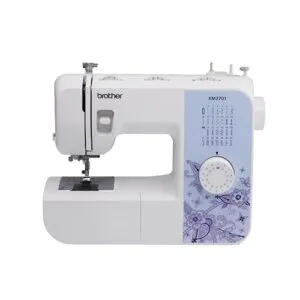
The Brother XM2701 Sewing Machine is a fantastic choice for beginners wanting versatility without hassle.
With 27 built-in stitches, including zigzag and stretch, it’s great for everyday projects. The jam-resistant bobbin keeps things running smoothly, and the automatic needle threader saves you headaches.
Whether you’re hemming, crafting, or tackling cuffs, its free arm makes tight spots a breeze.
Compact and lightweight, it’s easy to use and store. Bonus? Included accessories and free lifetime technical support make sewing stress-free and rewarding, providing a great experience with everyday projects.
Best For: Beginners and hobbyists looking for a lightweight, easy-to-use sewing machine with versatile stitching options.
- 27 built-in stitches, including decorative and stretch stitches, for versatility.
- Automatic needle threader and jam-resistant bobbin for smooth operation.
- Compact design with included accessories and free lifetime technical support.
- Warranty not valid outside the U.S. or at non-120 volts.
- Limited to beginner or intermediate sewing projects.
- Lacks advanced features for professional-level sewing.
2. Bernette 35 Swiss Design Sewing Machine
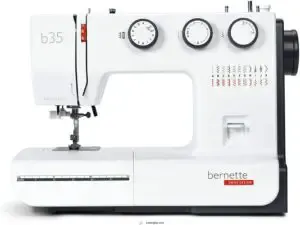
The Bernette 35 Swiss Design Sewing Machine combines simplicity with versatility, making it a solid choice for beginners.
It features 23 stitch options, a manual needle threader, and an automatic buttonhole for stress-free creativity.
The adjustable tension and intuitive controls guarantee smooth stitching across various fabrics, from silk to chiffon.
Its sturdy build, paired with thoughtful extras like seven presser feet, makes it reliable for light to medium projects.
While not ideal for denim, it’s portable, beginner-friendly, and easy to maintain.
Best For: Beginners and hobbyists looking for a reliable, easy-to-use mechanical sewing machine for light to medium projects.
- 23 stitch options with adjustable length and width for versatility.
- Includes seven presser feet and built-in accessory storage.
- Lightweight, portable, and straightforward to maintain.
- Not suitable for heavy-duty fabrics like denim.
- Short power cord reduces flexibility with foot pedal placement.
- Plastic construction may affect long-term durability.
3. Bernette 33 Swiss Design Sewing Machine
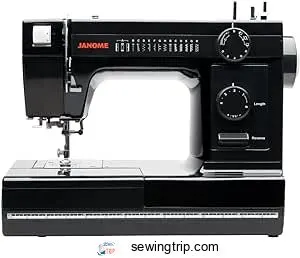
You’ll love the Bernette 33 Swiss Design for its simplicity and reliability.
It offers 15 versatile stitches, including buttonholes, making it a great companion for beginners. The built-in needle threader saves time, while the adjustable presser foot pressure guarantees smooth sewing on different fabrics.
With durable construction and easy-to-use non-slip knobs, it’s designed for confident stitching—no stress involved. Its robust performance and charming design make it a solid pick for mastering the basics.
Bernette machines also offer superior tension adjustments compared to some brands. Learning to sew? This might just be your perfect match for a great sewing experience with superior quality.
Best For: Beginners or intermediate users looking for a simple and reliable sewing machine with strong basic functions.
- Limited number of stitches compared to advanced models.
- No computerized features for modern conveniences.
- Basic design might not satisfy experienced sewers seeking advanced functionality.
- 15 versatile stitches, including buttonholes, for creative flexibility.
- Adjustable presser foot pressure for smooth sewing on various fabrics.
- Durable construction and easy-to-use knobs for confident operation.
4. Singer M1000 Sewing Machine
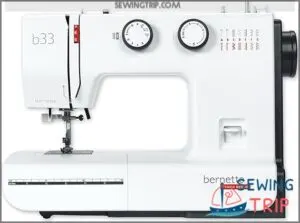
The Singer M1000 is a lightweight, compact sewing machine, perfect for quick mending or simple projects.
With 32 stitch applications and adjustable tension control, it handles various fabrics effortlessly. Setup is a breeze thanks to preset stitch settings, which beginners will appreciate.
At just 5.5 pounds, it’s easy to carry, making it travel-friendly. While it’s not meant for heavy-duty tasks, its affordability and simplicity make it a reliable choice for basic needs.
It’s small but mighty—ideal for on-the-go creativity, and offers a great balance of features and portability, making it a great option for those looking for a reliable choice.
Best For: Beginners or individuals seeking a lightweight and portable sewing machine for basic mending and simple projects.
- Lightweight and easy to transport at just 5.5 pounds.
- Beginner-friendly with preset stitch settings and simple setup.
- Affordable option for basic sewing needs.
- Not suitable for heavy-duty or advanced sewing tasks.
- Limited stitch options compared to more advanced machines.
- May struggle with thicker or layered fabrics.
5. Singer 7285Q Quilting Sewing Machine
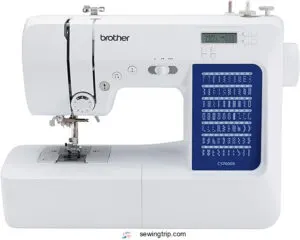
For quilters looking to spread their wings, the Singer 7285Q offers impressive versatility with 70 built-in stitches and a generous workspace.
You’ll appreciate the improved automatic needle threader that saves time on setup.
It comes fully equipped with a wide table, 10 sewing feet, and a quilt guide to help you tackle larger projects with confidence.
The metal frame provides stability even when working with heavy fabrics like denim or vinyl.
Though it has some plastic components, this machine serves both beginners and experienced sewers with its intuitive controls and quiet operation.
Best For: Quilters and sewers of all experience levels looking for a versatile, budget-friendly machine with advanced features.
- Offers 70 built-in stitches and 203 stitch applications for versatile sewing needs.
- Wide table and included accessories make it ideal for large quilting projects.
- Quiet operation and durable frame handle heavy fabrics effortlessly.
- Some plastic components may impact long-term durability.
- Needle threader has a tendency to fall off during use.
- Longevity concerns with electronic parts over extended use.
6. Janome Blue Couture Beginner Sewing Machine
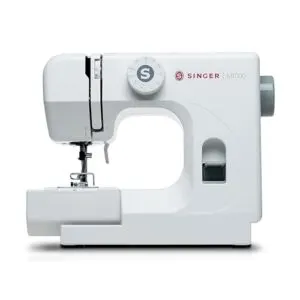
The Janome Blue Couture stands out as a beginner’s dream with its 15 versatile built-in stitches and user-friendly design.
You’ll appreciate the Ready-Set-Sew feature that gets you started quickly, while the four-step buttonhole makes creating professional-looking buttonholes a breeze.
The front-loading bobbin system offers easy access, and adjustable stitch length lets you customize your projects.
Best of all, this lightweight machine grows with your skills, making it both a practical first purchase and a long-term companion.
Janome’s trusted reputation guarantees reliable performance and excellent support.
Best For: Beginners and casual sewists looking for a lightweight, portable, and affordable sewing machine with essential features.
- Lightweight and portable for easy transport.
- User-friendly design with quick setup features.
- Trusted brand with reliable support and resources.
- Limited to basic and lightweight fabric projects.
- Not ideal for heavy-duty or advanced sewing tasks.
- Smaller number of built-in stitches compared to more advanced models.
7. Singer M3330 Beginner Sewing Machine with Accessory Kit
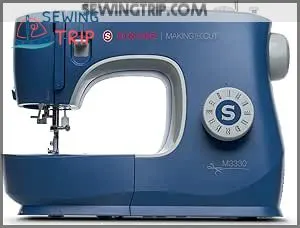
When you’re diving into sewing, the Singer M3330 makes it simple.
It offers 97 stitch applications, perfect for everything from basic fixes to decorative projects. Adjusting stitch length and width is a breeze, while the built-in needle threader saves time and frustration.
Its lightweight design and 11 essential accessories make it beginner-friendly yet versatile. Though setup might trip you up at first, a quick YouTube search can help.
For under $200, it’s a sturdy pick for budget-conscious beginners, offering great value with its 97 stitch applications and built-in needle threader.
Best For: Beginners and budget-conscious users looking for a versatile and portable sewing machine with essential features for basic and decorative projects.
- Initial setup can be challenging for some users.
- Side-loading bobbin may cause jamming issues.
- Slower stitching speed compared to vintage models.
- 97 stitch applications for diverse sewing needs.
- Lightweight and portable design with a sturdy metal frame.
- Built-in needle threader for easy setup.
8. Singer MX60 Portable Sewing Machine with Accessories
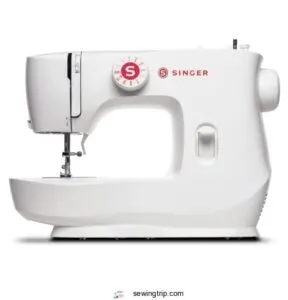
Compact yet powerful, the Singer MX60 makes sewing approachable for beginners.
Its 57 stitch applications cover basic and creative needs, while preset stitch settings eliminate guesswork.
Lightweight and portable, it’s perfect for small spaces or on-the-go projects.
The heavy-duty metal frame guarantees stability, delivering skip-free stitches every time.
Although a manual needle threader might slow things down, clear threading guides and simple controls make learning easy.
With affordability and ease of use, this machine lets you focus on mastering the craft.
Best For: Beginners and hobbyists looking for an easy-to-use, portable sewing machine for basic and creative projects.
- Lightweight and compact design for portability.
- 57 stitch applications with preset settings for ease of use.
- Heavy-duty metal frame ensures stability and skip-free stitching.
- No automatic needle threader included.
- Accessing the bobbin requires removing the casing.
- Some users find the foot pedal too lightweight, causing it to slide.
9. Janome HD3000 Heavy Duty Sewing Machine
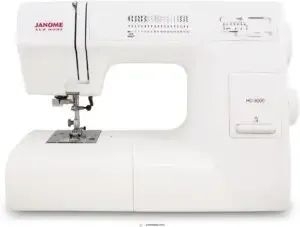
For heavy-duty projects, the Janome HD3000 is a reliable workhorse.
It’s sturdy, durable, and tackles thick fabrics like denim with ease, thanks to its metal frame and powerful motor.
With 18 built-in stitches, a one-step buttonhole, and an automatic needle threader, it simplifies sewing for beginners.
The machine’s top-loading bobbin system prevents jams, ensuring smooth operation.
While it excels at basic sewing, it’s not ideal for quilting large projects.
If you’re after versatility and longevity, this machine won’t disappoint.
Best For: Beginners or casual sewists looking for a durable, easy-to-use sewing machine for basic projects with thick fabrics.
- Durable metal frame ensures long-term reliability.
- Handles thick fabrics like denim with ease.
- Easy operation with jam-proof top-loading bobbin.
- Limited harp space makes it unsuitable for large quilting projects.
- Not powerful enough for heavy-duty industrial tasks.
- Lacks advanced features like an automatic thread cutter.
10. Brother GX37 Sewing Machine 37 Stitches 6 Feet
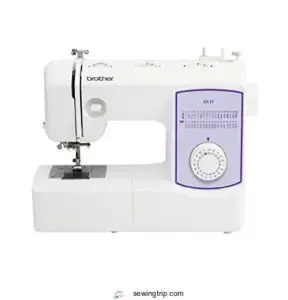
If versatility is what you’re after, the Brother GX37 won’t disappoint.
With 37 built-in stitches, including decorative and utility options, it’s perfect for tackling various projects.
Beginners will love its automatic needle threader, removing the frustration of threading by hand.
The six included sewing feet cover everything from zippers to buttonholes, adding flexibility, and the jam-resistant bobbin guarantees smooth sewing, even on thicker fabrics.
It’s lightweight and compact, making it easy to store and carry, and it’s reliable, approachable, and beginner-approved!
Best For: Beginners or intermediate users looking for a lightweight, easy-to-use sewing machine with versatile stitch options.
- 37 built-in stitches, including utility and decorative options, for a variety of projects.
- Automatic needle threader and jam-resistant bobbin for ease of use.
- Lightweight, compact design ideal for storage and portability.
- LED light may be too dim for some users.
- Not suitable for heavy-duty or advanced quilting projects.
- Plastic presser foot lever feels less sturdy compared to metal.
11. Singer SM024 Beginner Sewing Machine with Accessory Kit
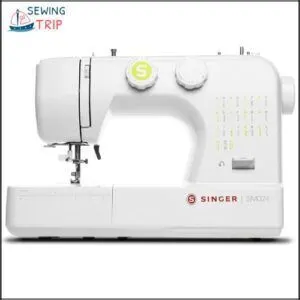
The Singer SM024 Beginner Sewing Machine with Accessory Kit is a great pick for learners.
It boasts 24 stitches, perfect for repairs or creative projects.
With an easy 4-step buttonhole, threading becomes stress-free—ideal for beginners tackling zippers or hems.
Its sturdy metal frame guarantees durability, while LED lighting keeps visibility sharp.
Users love the included accessories like presser feet and bobbins, saving time and money.
Some drawbacks? Occasional bobbins jams and threading challenges, but it’s still a dependable choice for small projects or hobbies.
Best For: Beginners and hobbyists looking for a budget-friendly sewing machine for simple repairs and creative projects.
- Durable all-metal frame provides steady support.
- Includes multiple accessories like presser feet and bobbins.
- LED lighting enhances visibility during sewing projects.
- Occasional bobbin jams and threading issues.
- Not ideal for thick fabrics; may struggle with heavier materials.
- Tension adjustments can be unreliable.
12. EverSewn Sparrow 15 Mechanical Sewing Machine
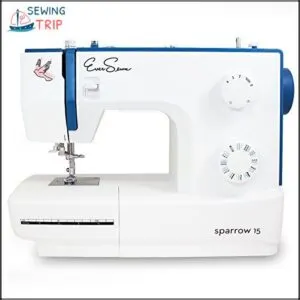
The EverSewn Sparrow 15 is like a friendly guide for beginners, blending simplicity with functionality.
It offers 32 built-in stitches, including utility, decorative, and quilting options, giving you plenty of versatility to explore.
The heavy-duty metal frame guarantees durability, while features like the side thread cutter and LED light add convenience.
Adjusting stitch length and tension is easy with intuitive knobs, making it lightweight and portable, which is perfect for small spaces or on-the-go sewing, and you’ll love its charm and practicality!
Best For: Beginners and hobbyists seeking a lightweight, portable, and easy-to-use sewing machine for light to moderate projects.
- 32 stitch options, including utility, decorative, and quilting.
- Durable metal frame with intuitive manual controls.
- Lightweight at 13.5 lbs, ideal for travel or small spaces.
- Noisy operation, especially at low speeds.
- Limited throat space, not suitable for large quilting projects.
- Reports of random stitch skipping and inconsistent performance.
13. Brother ST371HD Strong Tough Sewing Machine

If you’re looking for a durable yet beginner-friendly sewing machine, the Brother ST371HD is a solid pick.
With 37 built-in stitches, it handles everything from hemming jeans to sewing lightweight silks.
The automatic needle threader and jam-resistant drop-in bobbin simplify use, while the sturdy metal needle plate guarantees smooth fabric feeding.
It sews up to 800 stitches per minute and includes six presser feet for versatility.
Compact and easy to store, it’s perfect for tackling everyday projects and learning the basics confidently.
Best For: Beginners and intermediates seeking a durable, user-friendly sewing machine for everyday projects and handling thick fabrics.
- Handles thick fabrics like denim and outdoor materials with ease.
- Includes automatic needle threader and jam-resistant drop-in bobbin for simplicity.
- Compact design with six versatile presser feet for a variety of sewing tasks.
- Limited advanced features compared to computerized models.
- Buttonhole attachment functionality may be challenging for some users.
- Foot pedal issues reported in non-US regions due to voltage differences.
14. Singer Heavy Duty 4423 Sewing Machine with Accessory Kit
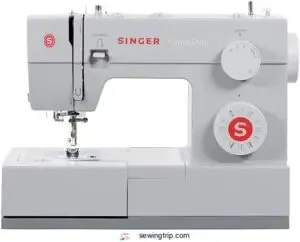
For beginners or seasoned crafters, a mechanical powerhouse like the Singer Heavy Duty 4423 proves invaluable.
With 97 stitch applications and a robust motor, it zips through denim and layers effortlessly, sewing up to 1,100 stitches per minute.
You’ll love the automatic needle threader for quick setups and adjustable presser foot pressure for tackling delicate fabrics.
Its sturdy metal frame promises durability, while the accessory kit guarantees you’re ready for diverse projects, making this machine reliable, fast, and practical—this machine covers all the bases.
Best For: Beginners and experienced sewers looking for an affordable, durable, and versatile machine for handling a wide variety of fabrics and projects.
- Powerful motor with 1,100 stitches per minute for high-speed sewing.
- 97 stitch applications including stretch and decorative options.
- Durable metal frame and included accessory kit for long-term use.
- Automatic needle threader can be a bit tricky to use at first.
- Limited warranty coverage on some components.
- Mechanical design lacks advanced computerized features.
15. Janome 2212 Sewing Machine 12 Stitches

With its 12 built-in stitches and four-step buttonhole, the Janome 2212 shines as a practical, no-frills choice.
Ideal for beginners, its simple dials make stitch selection straightforward, while adjustable stitch length and width guarantee precision.
This lightweight machine is perfect for transport but durable enough for years of use.
The free arm adds versatility for sewing cuffs or sleeves, and the smooth feed system tackles various fabrics with ease.
Affordable and reliable, it’s tailor-made for learning and creative exploration.
Best For: Beginners and hobbyists looking for an affordable, easy-to-use sewing machine.
- Lightweight and portable for easy transport.
- Adjustable stitch width and length for precision.
- Smooth operation on various fabrics with high-quality thread.
- Not compatible with low-quality threads.
- Limited dealer availability for replacement parts.
- Older model without advanced features for professionals.
Choosing The Right Mechanical Sewing Machine
Finding the right mechanical sewing machine starts with knowing your budget, sewing needs, and preferred features.
Don’t worry—choosing wisely now means you’ll avoid headaches later and enjoy a smoother learning experience.
Brand and Model Selection
When choosing the best starter sewing machine, prioritize brand reputation for reliability.
Renowned sewing machine brands like Brother, Janome, and Singer offer beginner-friendly models with solid construction, stitch variety, and practical accessories.
Consider machine weight for portability, especially if space is tight.
A good mechanical sewing machine balances function and simplicity, making it easier for beginners to master sewing basics comfortably.
Some brands like Babylock are known for serger innovation, which could be a consideration for future projects.
Budget Considerations
Stick to what fits your wallet! Affordable brands like Singer and Brother offer beginner sewing machines that balance quality and price.
Entry-level models save money upfront, but watch out for long-term costs like repair expenses.
Feature trade-offs are common—want simplicity over bells and whistles? A mechanical sewing machine is your best bet for a reliable, low-cost sewing machine that offers simplicity and is a good choice for those looking for a low-cost option.
Project Needs and Machine Purpose
Think about projects you’ll tackle.
Are you mending jeans or crafting quilts? Fabric compatibility matters—thicker materials need a durable mechanical sewing machine like the Janome HD3000.
For beginners tackling simple sewing projects, a basic sewing machine with stitch versatility can suffice.
Match the machine to your skill level and project complexity for a smooth, frustration-free experience.
Setting Up and Maintaining Mechanical Sewing Machines
Setting up and maintaining your mechanical sewing machine isn’t as tricky as it sounds.
With proper assembly, threading, and a little regular cleaning, you’ll keep your machine running smoothly for years.
Skipping key steps can lead to headaches later.
Unpacking and Assembling The Machine
When unpacking your mechanical sewing machine, check the parts inventory to verify nothing’s missing.
Choose a sturdy workspace setup with good lighting for easy assembly. Follow the manual for initial adjustments, aligning pieces carefully.
A beginner sewing machine is user-friendly, but troubleshooting assembly issues might still arise. Safety precautions matter—avoid plugging it in until everything’s secured.
Happy sewing!
Threading The Machine and Setting The Tension
How do you get perfect stitches? Begin with easy threading by following your beginner sewing machine‘s manual.
Correctly thread the needle, load the bobbin, and check its placement. Use good-quality thread suited to your needle type to avoid tension problems.
Proper technique is key when considering sewing machine threading kits. Adjust the mechanical sewing machine’s tension dial until stitches look smooth—neither too loose nor tight.
It’s straightforward once practiced, and with these steps, you can achieve smooth stitches and ensure your sewing machine is properly set up for easy threading.
Cleaning The Machine and Oiling The Parts
When maintaining your mechanical sewing machine, regular sewing machine cleaning is key.
Remove lint using a soft brush or compressed air.
Follow the maintenance schedule for oiling—use only correct oils specified by the manufacturer.
Oiling frequency depends on usage but keep it consistent.
Proper sewing machine lubrication guarantees smooth operation.
Avoid over-oiling, as it attracts dust, complicating future sewing machine maintenance.
Tips for Extending The Machine’s Lifespan
After sewing machine cleaning and lubrication, keep your machine humming smoothly with regular care.
Replace needles often to prevent fabric tears, and use proper storage solutions to protect it from dust. Don’t skip sewing machine maintenance—schedule professional servicing yearly.
Regular oiling keeps parts running like clockwork, while simple sewing machine troubleshooting avoids bigger problems down the line.
To keep your machine in top shape, remember to oil moving parts weekly.
Frequently Asked Questions (FAQs)
Which sewing machine has the least problems for beginners?
Nearly 90% of beginners choose the Brother GX37 for its ease.
With 37 stitches, a lightweight build, and user-friendly dials, it simplifies sewing.
You’ll avoid headaches while learning, thanks to its intuitive design.
Are mechanical sewing machines better?
Mechanical sewing machines aren’t necessarily better, but they’re great for beginners.
They’re simple, durable, and budget-friendly. With fewer features, you’ll focus on mastering basics without juggling tech.
Think of them as reliable training wheels for sewing, helping you to learn and improve your skills without the distraction of complex features.
Is a computerized sewing machine good for beginners?
A computerized sewing machine can be great for beginners if you’re tech-savvy.
With features like automatic threading and pre-programmed stitches, it simplifies tasks, but it might feel overwhelming compared to the simplicity of mechanical machines, which is why beginners should consider their needs carefully.
Is Brother or Janome a better sewing machine?
Choosing between Brother and Janome is like picking your favorite tool in a toolkit—both shine differently.
Brother offers budget-friendly ease for beginners, while Janome stands out with durability and handling tougher projects.
Can a beginner use a computerized sewing machine?
Beginners can use a computerized sewing machine.
It offers automatic settings, making tasks easier.
While there’s a learning curve, patience and practice help.
Plus, built-in tutorials can be a life-saver when you’re stuck!
What is the easiest sewing machine for seniors?
You’ll love the Brother CS7000X.
It’s lightweight, easy to use, and has large buttons and an LCD screen for clear settings.
The automatic needle threader saves time, making sewing simpler for seniors.
Is a mechanical sewing machine good for beginners?
Mechanical sewing machines are perfect for beginners.
They’re simple, sturdy, and easy to control with manual dials, letting you focus on mastering the basics.
No overwhelming features, just straightforward sewing fun at your own pace.
They offer a great way to learn the fundamentals of sewing without the complexity of computerized machines.
What is the most beginner-friendly sewing machine?
Every journey starts with the right tool—like the Brother GX37.
It’s user-friendly, with 37 built-in stitches, easy controls, and portability.
It’s reliable, simple to use, and perfect for building your sewing skills.
Which manual sewing machine is the best?
The Singer Start 1304 is a top pick for a manual sewing machine.
It’s simple to use, affordable, and perfect for beginners.
With six stitches and an easy threading system, frustration stays minimal, making it a great choice with a key feature being simple to use.
Which mechanical sewing machine is best?
You can’t go wrong with the Singer Making the Cut for its versatility or the Janome HD3000 for durability.
Both offer easy controls and consistency, making them top picks for reliable, beginner-friendly sewing.
Conclusion
Think of mechanical sewing machines as the vinyl records of the sewing world—timeless, reliable, and beginner-friendly.
Choosing the best mechanical sewing machines for beginners means finding a balance between simplicity, durability, and practical features like automatic needle threaders or adjustable stitch settings.
Whether it’s mending torn jeans or sewing curtains, these machines are perfect for discovering your creative spark without unnecessary complications.
Pick a model that fits your needs, and start your sewing journey with confidence!

